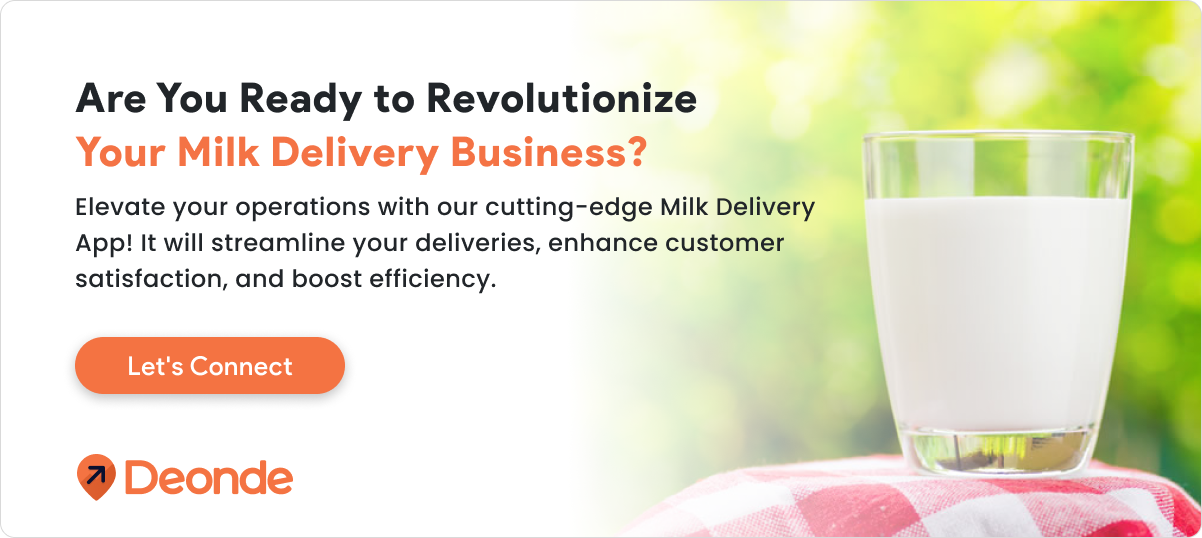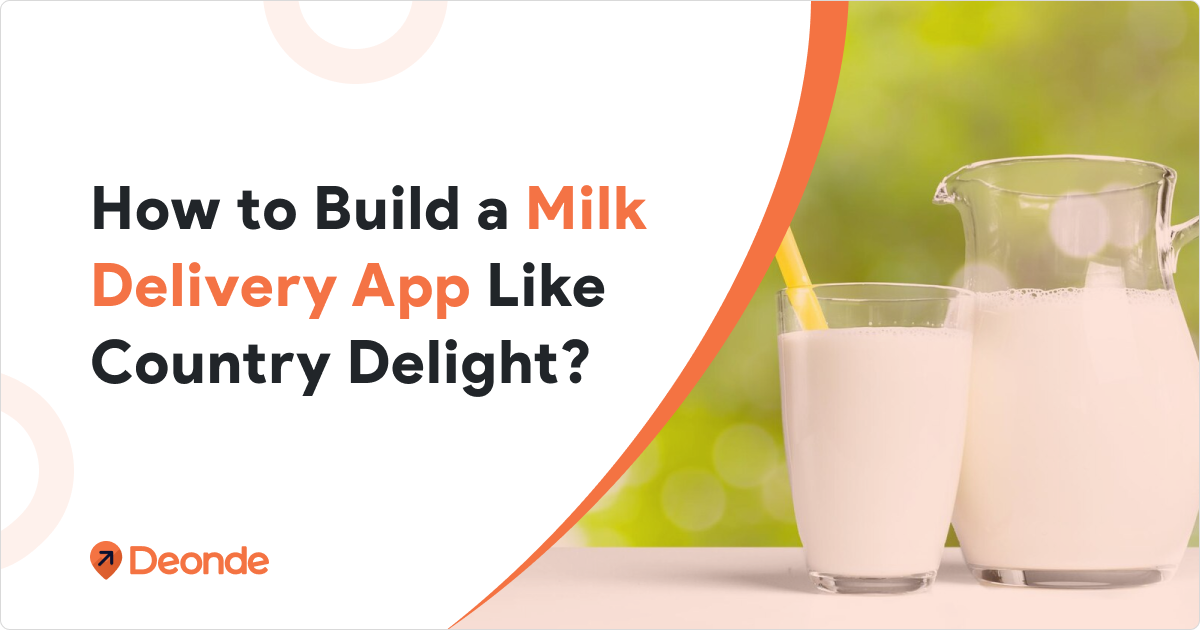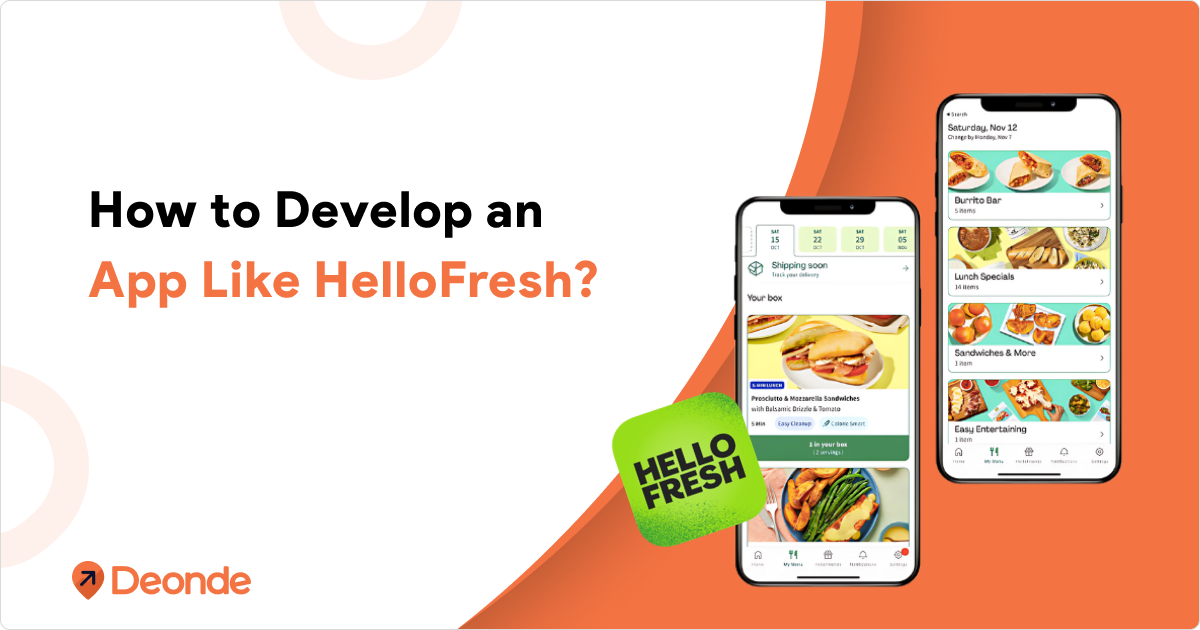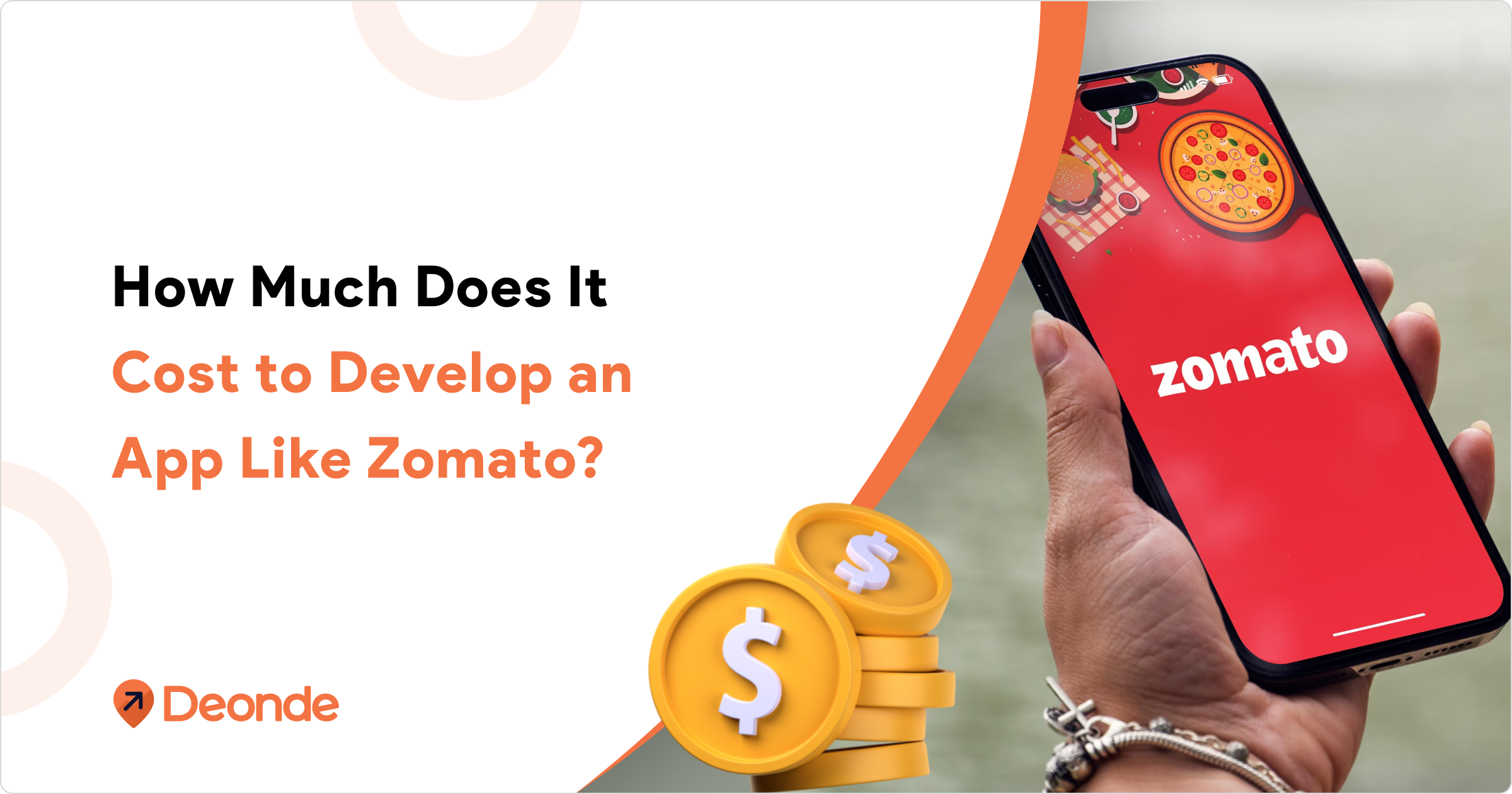On-demand milk ordering and delivery solutions are gaining popularity around the world. According to Statista, the revenue in the milk market is projected to reach US $21.96 Bn this year.
So, if you’re thinking of building a milk delivery app like Country Delight or Milk Basket, this is a must-read for you.
In this comprehensive milk delivery app development guide, we’ll take you through the entire process of milk delivery app development. We’ll also understand a bit about Country Delight’s business model and ways you can emulate it to kick-start your own milk delivery app business.
Let’s start right away!
Milk Delivery Apps and Their Types
A milk delivery software is a cloud-based technology platform, designed to simplify the process of ordering and delivering milk.
A milk delivery app can entirely replace the conventional models of milk delivery. No more going to the dairy to buy milk or milk products. The entire process of buying milk and milk products is fast-tracked through milk delivery apps, which bring buyers, sellers, and drivers to a common online interface.
Milk is an important part of the staple diet, and most people drink milk regularly. Hence, a subscription-based model for milk delivery works best.
Before we talk about how to build such a business, let’s quickly explore the types of milk delivery apps:
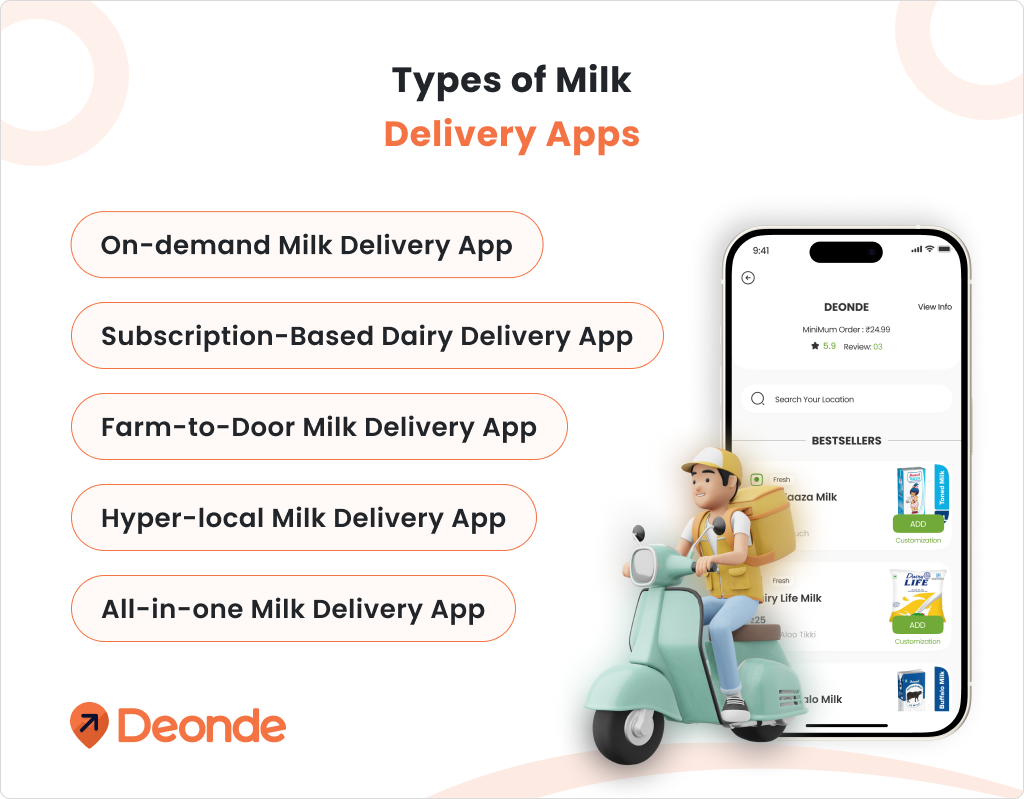
1) On-demand Milk Delivery Apps:
Customers can place orders for milk and its products whenever they like—without any time constraints. It is perfect for customers who need milk to be delivered urgently.
2) Subscription-Based Dairy Delivery Apps:
This category of on-demand milk delivery apps allows customers to subscribe to a milk delivery service provider on a month-on-month basis. This is a much more convenient model, as it doesn’t require buyers to place their orders every day.
3) Farm-to-Door Milk Delivery Apps:
These apps connect customers with hyper-local farm or dairy owners who organically source their dairy products. The farm-to-door milk app serves a unique customer segment, providing services to those who are seeking unprocessed and organically produced milk.
4) Hyper-local Milk Delivery App:
Hyper-local milk delivery apps focus on specific geographic locations. It connects users with only those milk distributors that are closest to them. This kind of area specificity is important to ensure fast and efficient delivery of milk products.
5) All-in-one Milk Delivery App:
A one-stop solution for milk delivery as it enables users to browse hyper-local sellers or dairy owners. Customers can either subscribe to a desired service provider or order milk on the go—without any subscriptions.
Country Delight’s Business Model
So, you want to build an app like Country Delight?
But first, let’s go through the business model of Country Delight and understand the source of their revenue.
Country Delight is a holistic milk and grocery delivery software that connects consumers to milk vendors, farmers, and dairies.
You can also order everyday groceries, yogurt, eggs, and vegetables using Country Delight. Today, Country Delight is available in major cities of India like Mumbai, Hyderabad, Bangalore, Chandigarh, Chennai, Delhi, Jaipur, and Pune.
What sets apart Country Delight from other on-demand delivery apps is the fact that it conducts both late-night and early-morning deliveries. This makes it really convenient for the consumers—in case they need milk products at odd hours.
Here’s a complete breakdown of Country Delight’s Business Model:
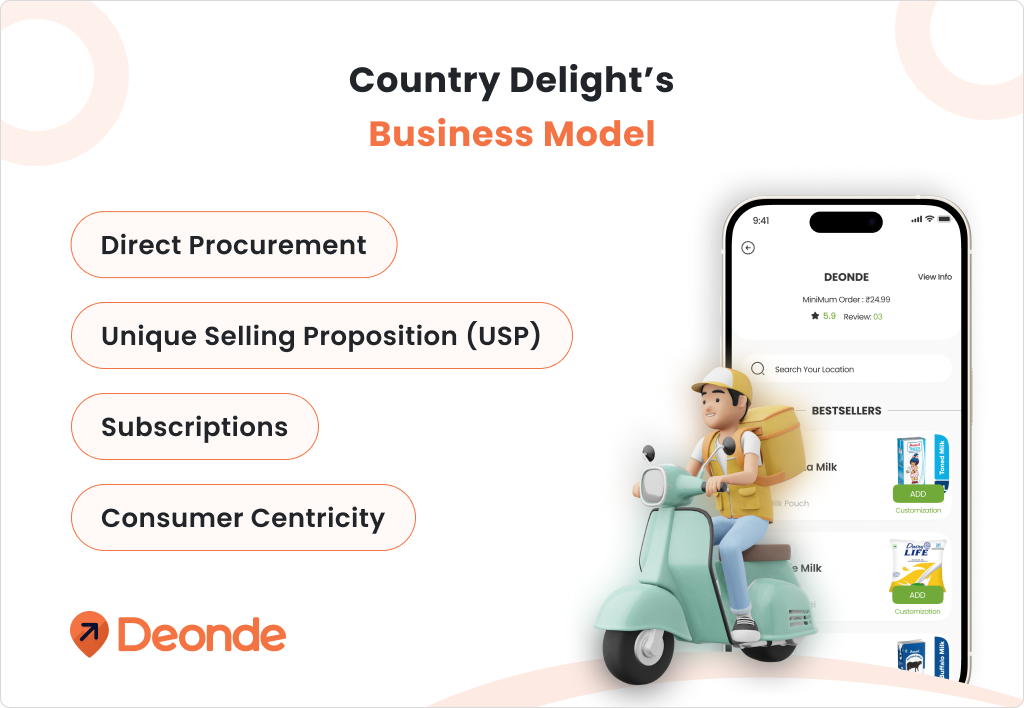
1) Direct Procurement
Country Delight collaborates directly with nearby farmers and dairies for inventory. Procuring straight from the source means they’ve successfully eliminated the middleman, like retailers or supermarkets. Hence, the organization can sustain high profit margins and scale with ease.
2) Unique Selling Proposition (USP)
Country Delight prides itself on supplying groceries and milk straight from the farms. The farm-to-door model helps capture consumers looking for high-quality, organically sourced products. They also enforce health codes and quality assurance regulations to ensure that only premium quality products are sent out for delivery.
3) Subscriptions!
Country Delight is a subscription-based milk delivery app. Here, consumers are expected to select a subscription plan for ordering. This model works best as the milk and grocery market is known for price fluctuations and inflation. Thus, a subscription-based model allows Country Delight to have a predictable and recurrent source of revenue—-even in unstable markets.
4) Consumer Centricity
The business model of Country Delight is focused on maximizing consumer convenience. The app streamlines ordering and has plenty of room for customizing orders. Additionally, it also automates payment transactions for subscribers. Further, it enhances the browsing experience by suggesting products that align with the user’s preferences and order history.
With 24/7 customer service and prompt resolution of customer concerts, Country Delight has focused the business on customers. As a result, their CSAT scores are better than most milk delivery apps and they have a higher-than-average customer retention rate.
Why Develop a Milk Delivery App like Country Delight?
Taking a conventional milk delivery model and optimizing it digitally can do wonders. In business terms, it can boost revenue and profits and even save hours on manual tasks. If you’re thinking of starting a milk delivery business, you must invest in a milk delivery system—as it’s only going to make your life easier.
How To Start a Milk Delivery Business That Generates Revenue?
Let’s look at some of the reasons why you should be investing in a milk delivery app:

1) Higher Customer Retention
Acquire and retain more customers through discounts, seamless deliveries, and dedicated customer support. By ordering online, customers experience a whole new level of convenience.
For instance, the payments are automated, the delivery process can be tracked in real-time, and they never have to leave the house to buy milk again. Leverage these functionalities to retain customers and heighten customer satisfaction.
2) Revenue Boost:
Upscale your revenue by capturing a wide array of target consumers online. Serve organic delectables or vegan milk products and cater to unique, high-end customers. With an online platform, you’ve plenty of opportunities to upsell and cross-sell. You can also generate recurrent revenue through the subscription-based milk delivery model.
3) Get Competitive Advantage:
The concept of ordering and delivering milk is still in its nascent stage. Not a lot of Indian milk vendors have moved their business online. This is a perfect opportunity for you to get ahead of the crowd and develop milk delivery software. Not only will this give you a competitive edge, but it’ll also provide you with the first-mover advantage.
4) Build a Brand:
A consistent brand image can boost your sales by 23%. With a milk delivery app platform, you have the chance to build a memorable brand for your online customers. You can also do omnichannel marketing and 3X your current customer acquisition numbers. Building a brand is an important aspect of running a business, and you can do that seamlessly with milk delivery software. Use discounts, push notifications, or social media integrations to boost brand engagement.
How to Develop a Milk Delivery App like Country Delight:
The process of developing a milk delivery app like Country Delight can be daunting. Especially if you’ve never thought of doing this before. But no worries—we’re here to help you and make this easy.
In this section, we’ll dig deep to understand the steps of developing an app like Country Delight.
Keep reading for more:
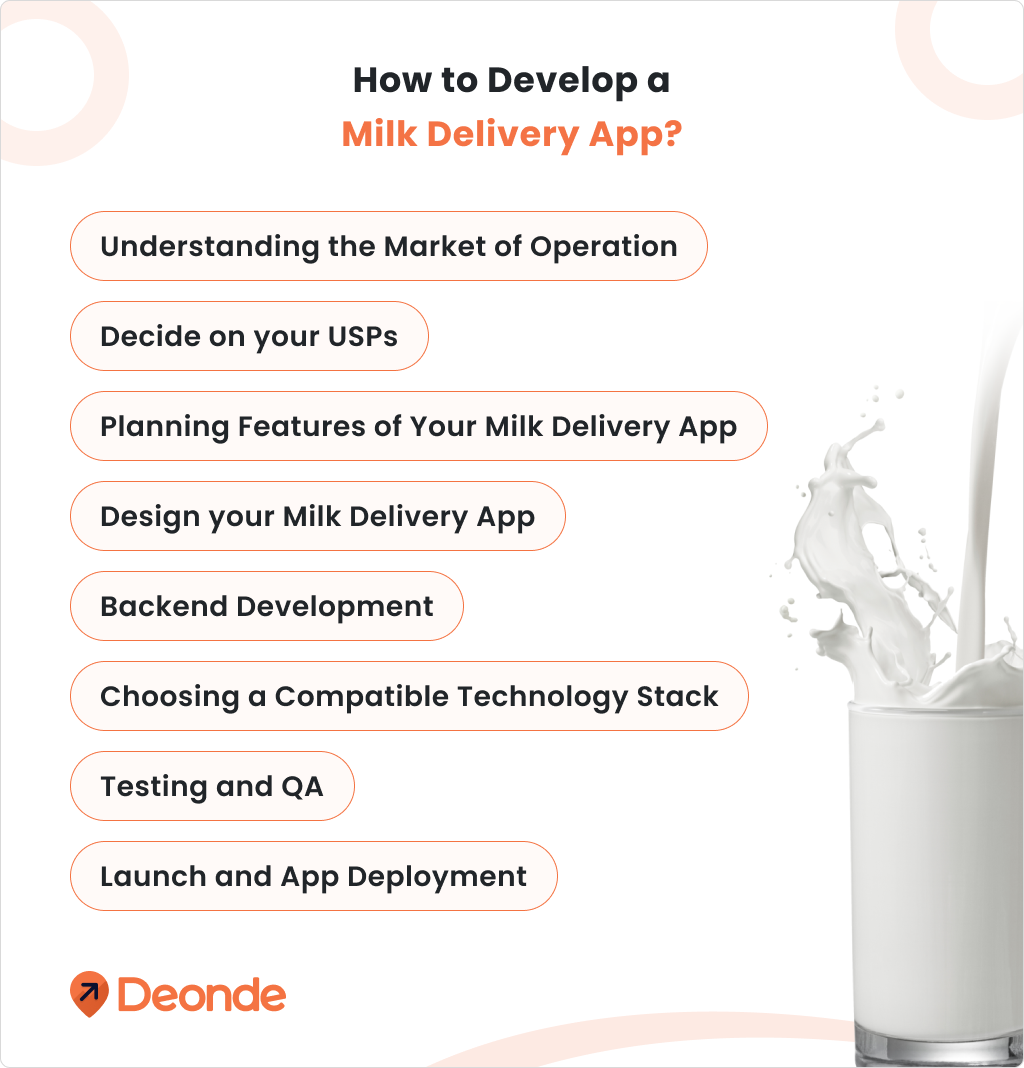
Step 1: Understanding the Market of Operation
It’s best to build a business on thorough research and tangible data.
This is why we recommend conducting surveys and hosting focus groups to truly understand the needs of the hour. Get insight into major pain points or challenges—and develop a milk delivery app that addresses them.
You can also decide on the range of milk products you’d like to sell through research and surveys. Understand your target consumer’s daily milk requirement and tailor your menu around it.
Next, you could also look at your competitors like Country Delight, Milk Basket, Milkwala,
Or DailyMoo. Analyze their app features, customer reviews, and marketing strategies to identify what’s working in the market and what isn’t.
Use competitor strategy as a starting point and optimize it for better results.
Step 2: Decide on your USPs
To stand out from the crowd, you need to clearly define and communicate your milk delivery app’s USP. It can be as simple as supplying high-quality products or making last-mile deliveries sustainable through EV fleets.
Commit to your USP and connect with target consumers who’d appreciate your company values. For instance, selling organically sourced milk products would help you cater to consumers who like consuming un-adulterated, preservative, chemical-free milk.
If you’re struggling to define your USP, go back to your research data and pick a point. Ideally, your USP should be either solving or circumventing that pain point.
Step 3: Planning Features of Your Milk Delivery App
Develop an app with a full range of advanced features and modules. Make these features accessible and easy to use.
Meanwhile, here are some of the top features of a successful milk delivery app that you simply cannot miss:
A) Real-time Delivery Tracking
Enable users to check on their orders in real-time through GPS tracking and real-time updates. The order confirmation notification typically includes an order ID, order summary, and estimated delivery timings. It also includes a live-tracking segment where users can see the movement of delivery drivers in real time.
B) Order Customization
Customers should have the freedom to browse seamlessly and add products to the cart before checkout. Also, include functionality to adjust quantities of ordered products for maximum convenience.
C) Refund Policy
Instill trust by setting up a transparent and fair refund policy. Train customer service reps to escalate and resolve customer queries promptly. You can also integrate customer servicing AI tools to heighten customer satisfaction.
D) Inventory Management
Track inventory and optimize milk procurement and supply. This will mitigate losses due to milk spoilage or inventory shortages. Track average daily orders and leverage data insights for efficient inventory management.
E) In-app Communication Channels
Facilitate conversations through the milk delivery app through in-app chatting or voice calls. This will reduce the need for you to follow up on delivery drivers or customers.
Step 4: Design your Milk Delivery App
First impressions last forever—hence, designing the UI/UX for your app should be a fairly intensive process involving multiple mock-ups, wireframes, and design templates. We suggest following an iterative feedback model to fast-track designs.
Here are a few tips to get you started:
- Keep it simple and intuitive.
- Place CTA and Navigation buttons within the line of sight
- Make sure your design is high-responsive
- Design for all screens—mobile, tables, and laptops
- Personalize the design to reflect your brand
Step 5: Backend Development
Implement a robust, agile backend database for information storage and processing. Your priority here should lie in securing all backend processes. Encrypt data and use reliable third-party integrations for order placement, payment processing, and customer data management.
Also, make sure your backend process can handle more workload as your business grows. Make it flexible and agile—so when the time comes, you can scale seamlessly.
Step 6: Choosing a Compatible Technology Stack
Firstly, you need to make sure your app is compatible with all operating systems. Use frameworks like React Native or Flutter for cross-platform development. For Backend Development, we recommend using a robust interface like Node.js, Django, or Ruby on Rails. Use reliable databases like MySQL, PostgreSQL, or MongoDB for efficient data management.
Lastly, take your app online with Cloud Services like AWS or Google Cloud. Inspect cloud space and user seats carefully before purchasing a cloud-service subscription.
Tech Stack & for Developing an App in a Nutshell
- Front-end Development Tools: HTML, CSS, JavaScript
- Mobile Platforms: Android, iOS
- Back-end Technologies: Node.js, PHP
- Authentication: OAuth, JWT
- Programming Languages: Java, React, and Laravel
- Payment Gateways: PayPal, Google Pay, Apple Pay, and E-Wallets
- Cloud Services: AWS, Google Cloud Platform, Azure
- Real-time Tracking System: GPS, Google Maps API
- Real-time Analytics: Hadoop, Spark, IBM, Cisco
- Security Measures: SSL, Encryption
Step 7: Testing and QA
Testing is essential because it’s the only way you’ll find out if your milk delivery is functional or not. There are two approaches you can take when it comes to testing your milk delivery app:
A) Functional Testing
As the name suggests, this type of testing confirms that every feature in your app is functional and responsive. It includes:
- App installation and launching
- User signup/login
- All navigational and action buttons are working
- Push notifications are correctly triggered
- Seamless transaction without the loss of privacy
B) Beta Testing
This form of testing involves a soft launch, where a selected group of test consumers are invited to use the app. Their experience and feedback are documented. Further app development is then driven by the test group’s feedback.
Address bugs or issues identified during the testing phases and make your app stable. Even post-testing, monitor the app regularly and optimize its performance through regular updates and app fixes.
Step 8: Launch and App Deployment
Now that we are done with testing and debugging—your app is flawless and ready to be deployed. However, you still need a plan to launch it.
We recommend you start with a soft launch to test the waters. Observe how your milk delivery app is doing in real-world scenarios.
Next, you need to optimize your app store optimization: Put relevant keywords and descriptions to your Play Store and App Store accounts.
Affiliate marketing has become particularly effective for app marketing. Use it to spread the word. You can also offer exclusive discounts for first-time users and encourage them to invite friends and family for bonuses.
Meanwhile, start building partnerships with milk vendors and resellers. They can be a valuable resource to promote your app.
The Cost of Developing a Milk Delivery App like Country Delight
Creating a milk delivery app like Country Delight can be expensive. It involves hefty investments in tech infrastructure and human resources. You need coders, designers, developers, testers, and marketers to make and launch your app.
Based on your geographical location, this entire process may cost you upwards of USD 50,000.
Again, the cost here is extremely subjective. It can vary depending on the type of features you choose, integrations, cloud service subscriptions, and resource compensation.
If you’re planning to launch your business on a tight budget, developing a milk delivery app from scratch is certainly not the way to go. This is why we recommend exploring white-label milk delivery solutions from Deonde.
What’s in it for you? You can kick-start your milk delivery business for under $100/month by opting for SaaS-based white delivery solutions.
This will save you from hefty investments and help you lift your business—even if you’re operating within tight budgets.
Why Choose Deonde’s SaaS-based Milk Delivery Software?
Here are three big reasons why you should consider getting on board with Deonde!
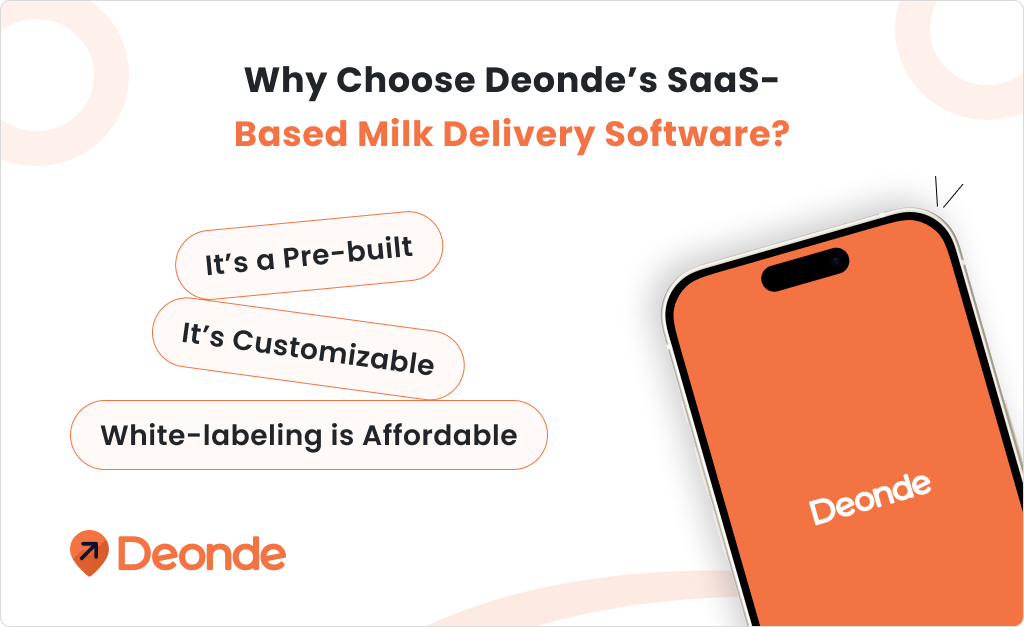
- It’s a Pre-built
With a few tweaks, your on-demand milk delivery app will be ready for launch.
- It’s Customizable
Change the features, elements, buttons, style, and layout to your liking.
- White-labeling is Affordable!
Developing a milk delivery app from scratch requires a lot of resources. On the other hand, SaaS-based white-label solutions like Deonde don’t need any hefty investments. Start with as little as $100/month!
Additionally, Deonde offers exclusive features like user role management, call center dashboard, custom domain, vendor and driver settlements, and automatic driver allocation. With these modules, you’ll quickly outdo your competition.
How can I start a Milk Delivery Business in India?
We understand that starting a milk delivery business in India can be overwhelming. But we at Deonde want to help you through each step of this process. To get you started, we’ve some actionable tips you can implement to start your very own milk delivery business in India:

1) Research and Planning
Be thorough in your market research. Look at market demand, supply chains, competitors, and challenges. If it helps, try doing a SWOT analysis to understand your business’s strengths, weaknesses, opportunities, and threats.
2) Oblige to Legal Requirements
Ensure you have researched all the legal steps to registering and establishing your milk delivery business. Follow up on privacy and data protection compliance and obtain the necessary licenses to run such a business.
3) Supply Chain Management
Establish your procurement and supply centres. Partner with multiple milk sellers or dairies to ensure a steady supply of fresh milk and milk products. You must also invest in a fleet service provider who can manage fleets and drivers for you. If you want to do this for yourself, you must hire drivers.
4) Customize your Milk Delivery App
Develop a milk delivery app like Country Delight to streamline ordering, payments, and delivery tracking. But then, take one step extra and customize feature modules to serve your customers better. Customers per personalized buying experiences and are bound to come back for more.
Conclusion
A milk delivery app is probably the best investment you’ll make if you’re starting your own business. In this guide, we looked at the types of milk delivery apps and the business model of milk delivery apps like Country Delight. Use these as an inspiration to develop your milk delivery system.
We’ve also outlined the step-by-step process of developing your milk delivery app. But since this process is very intensive, we suggested a way out.
The solution is to get started with our ready-to-use white-label milk delivery software. Don’t just dream about starting your milk delivery business. It’s done with Deonde.
Frequently Asked Questions (FAQ’s)
1) What are some of the first steps in developing a Milk Delivery App?
A: You must begin with solid research and data. Let customer demands and expectations be your guide when you first start planning and designing your milk delivery app. Next, you need to narrow down your app’s USP. Come up with a proposition that stands out from competing milk delivery apps.
2) What features are essential for a Milk Delivery App?
A: Key features of a milk delivery app include user login, profile registration, menu management, Milk Subscription Management, order placement, order customization, payment gateway integration, push notifications, live tracking, inventory management, e-wallet, and in-app customer support.
3) Why should you consider a subscription-based Milk Delivery Business Model?
A: One of the main reasons most milk delivery app businesses consider the subscription-based revenue model is that it can help generate sustainable profit margins. The market of milk delivery is volatile and young businesses need a steady stream of revenue to operate. A subscription model provides consistent revenue and helps build long-term customer relationships.
4) How can I handle the last-mile logistics operations of my Milk Delivery App?
A: There are certain tools embedded in Deonde’s milk delivery app that can help you streamline last-mile logistics. To give you an example. Deonde’s milk delivery system can automate delivery allocation and optimize routing. This means the system handles delivery assignment, route planning, order batching, and tracking—while you sit back and relax.
